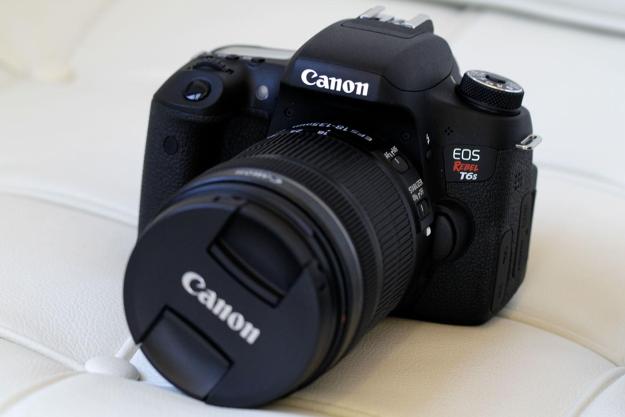
“Don’t call it entry-level: The T6s has a few advanced features that make it stand out from its Rebel siblings.”
- Excellent stills
- New 24-megapixel sensor
- Status LCD panel
- Wi-Fi/NFC for sharing
- Fast response, focusing
- 30p videos a bit humdrum
- Small viewfinder
- Wireless pairing could be improved
Editors’ note: The EOS Rebel T6i and EOS Rebel T6s are nearly identical cameras that use the same internal components, but cater to slightly different users. The T6s has some cosmetic differences and advanced features, such as a status LCD, manual exposure control, digital zoom, and enhanced grip. But in terms of photo and video quality, results are the same. The following review is about both cameras, but we’ve noted the differences where appropriate.
Canon’s EOS Rebel-series cameras are not only popular entry-level consumer DSLRs, but they are also strong performers. The latest Rebel is not one, but two very similar models: the EOS Rebel T6i and T6s. Both use a brand-new 24.2-megapixel APS-C sensor – the highest currently available form Canon – and are the first Rebel models to come with Wi-Fi and near-field communication (NFC).
The T6i ($750, body only) is a natural evolution of the T5i (which remains in the lineup, as a lower-price model), but what do you get for $100 more, in the T6s ($850)? The T6s uses the same body, but has a few more enthusiast-centric features, like a status LCD.
In today’s uber-competitive interchangeable lens camera (ILC) market, can Canon’s Rebel stay on top? And are the T6’s extra features worth the cost?
Features and design
DSLRs generally all look alike, and Canon certainly didn’t break the mold with this pair. While the T6i resembles previous entry-level Rebels, the T6s looks more like an enthusiast camera, such as the EOS 70D. The key reason for the latter is the monochrome LCD on the top deck that gives you a quick glance of your settings and status. This handy readout is designed for more experienced shutterbugs, so Canon created this Rebel for that customer who wants advanced options but doesn’t want to drop more than $1,000 for an enthusiast DSLR – someone who’s graduated past entry-level but doesn’t want a heavier, more advanced model. The T6s also has loads of tweaks for customizing your images, while the T6i is for casual photographers.
Even though, specs wise, the pair is very similar, the T6s feels much more substantial and weighs 0.4 ounces more (you won’t notice it). The T6s’ grip is a bit wider and overall it just feels better. Exterior measurements are identical – 5.2 x 4 x 3.1 inches (without a lens) and weight is around 20 ounces with battery and card.
If you’re stepping up from an older Rebel and you already have lenses, you can purchase either camera as body-only options. For new buyers, the T6i comes with two kit lens options, and the T6s has one. For $850 (that’s MSRP, so do some price comparison), you can get the T6i with an EF-S 18-55mm f/3.5-5.6 IS STM lens. You can also opt for the EF-S 18-135mm f/3.5-5.6 IS STM package for $1,049; this is also the kit lens offered with the T6s, for $1,149. (Quick primer: EF-S is Canon’s lenses made for APS-C sensors, IS stands for image stabilization, and STM refers to the built-in stepping motor for noise-free zooms when shooting videos.)
The difference between the two lenses is focal range – the 18-135mm gives you longer zoom. If you were to buy the lenses on their own ($250 and $550, respectively), it’s a $300 difference. So, in our opinion, it makes more sense to go with the longer lens if the budget allows; splurge further for the T6s if you can swing it. If you already own Canon lenses or you want something different, skip the kit options. (Oftentimes, warehouse stores, like Costco, will offer a two-lens kit, so look out for those.)
Both cameras have the Canon EF mount on the front, which is compatible with not just the loads of Canon EF and EF-S options, but also the many third-party lenses out there (lenses are a Canon strong point). There’s also lens release and depth-of-field preview button (to help determine how much of the scene you want in focus), a remote sensor on the grip, and a red-eye reduction/self-timer lamp.
You won’t go wrong with the new Rebel, but you should also look closely at the competition.
The top decks are where you’ll really notice they are two separate cameras. As mentioned, the T6s has a LCD readout on the right side. To accommodate the LCD, the mode dial (with locking mechanism, which the T6i doesn’t have) and off/on/movie lever were shifted to the left side. There are buttons for ISO, AF area selection, and shutter, as well as a jog wheel, but they are all slightly repositioned (the T6s has a button for illuminating the mono LCD, while the T6i has a Wi-Fi indicator). Both cameras offer the same modes: smart auto, PASM, scene (five options), sports, macro, landscape, portrait, creative auto (special effects), and flash off.
The rear panels are fairly similar with .82x optical viewfinders and 3-inch vari-angle touchscreen color LCDs (rated 1,040K dots). LCD brightness is generally good but you’ll want to crank up the brightness in bright daylight when using live view. The touchscreen makes it easy to move through the menus and make changes. The viewfinder, while perfectly useable, is rather small when compared to higher-end DSLRs.
While you’ll find the same buttons and controls in both the T6s and T6i, where they are located is slightly different. But the T6s has a Quick Control Dial around the four-way controller; the T6i does not.
The right has the SD card slot, and the left has two sealed panels, one for HDMI and USB/AV digital out, and the other for a remote and optional mic.
On the bottom is the tripod screw mount,
Compared with actual enthusiast DSLRs, the T6s has similar attributes. The top monochrome LCD, Quick Control Dial, and mode dial locking lever to prevent inadvertent changes while shooting. But enthusiast DSLRs have tougher construction and some are weather resistant. Also, they have larger viewfinders and other pro-centric features and performance (like faster shutter speeds and stronger autofocus systems). While the T6s embodies the spirit of an enthusiast DSLR, at heart it’s still an entry-level Rebel.
What’s included
For our review, Canon supplied us with two kits: a T6i with an 18-55mm lens, and a T6s with an 18-135mm lens.
Regardless of the kit you purchase, all T6s and T6i cameras come with the battery, plug-in charger, eyecup, strap, and USB cable. Canon supplies printed manuals (200-plus pages), a CD with a variety of programs for developing RAW files and managing your images, and another CD with the full owner’s manual.
Warranty
Canon offers a typical one-year warranty for parts and labor. Canon offers an extended warranty plan, called CarePak Plus, that covers accidental damage and live support. The T6s and T6i may be entry level, but they are still expensive. Canon has a good service program and may be well-worth the investment if you’re prone to accidents.
Performance, specs, and use
After sticking with its 18-megapixel APS-C CMOS sensor for what seemed like forever, we’re happy Canon has finally upgraded the Rebels to a new 24.2-megapixel APS-C CMOS sensor. Canon is now on the same playing field, sensor wise, as Nikon and Sony, which have had 24-megapixel APS-C ILCs for a while now.
The latest Rebels are also using the newer Digic 6 image processor, so the cameras are quite responsive (5 frames per second). The Hybrid CMOS AF III autofocusing is also speedy and we had no focus issues during testing. However, shutter speed tops out at 1/4000, and the number of autofocus points is much less (19), compared to 1/8000 and 51 points of the $1,199 (body-only) Nikon D7200 enthusiast DSLR.
We used the pair simultaneously, for several weeks, shooting a wide variety of stills and videos. Photographic results for the duo are really quite fine with that natural Canon “feel” that we’ve always appreciated. Colors are as accurate as can be, with a richness that every shutterbug will like. Photo quality results, overall, were outstanding.
We preferred shooting with the T6s and the 18-135mm stabilized zoom and better grip, but the more affordable T6i also delivers the photographic goods with the basic 18-55mm lens. You can’t go wrong with either, and it all depends on your level of comfort. Casual? Go with the T6i. More of an enthusiast? The T6s is the pick. Note that the T6s offers digital zoom, but we’d rather use true optical zoom.
The Rebels have native ISO ranges of 100-12,800, but the T6s can be expanded to 25,600. Overall, the T6s has many more customization options than the T6i, but as far as sensitivity results are concerned both are solid. Even with the 24MP sensor, there was little noise at ISO 3,200 and 6,400. You really have to enlarge your images to see digital artifacts, so you should have no problems shooting in dim light, especially if you have a wide-open (f/2.0) prime lens.
As for movies, we aren’t sure why, but Canon is sticking with 1080/30p videos while competitors are moving to 1080/60p or higher. It’s a shame since the T6s has advanced features built for shooting movies, like manual exposure control and microphone jack.
In our sample videos, color quality was good but there were occasional problems with focus as the level of light changed. Bright sunshine is must when using these Rebels as camcorders. Overall, reviewing the clips felt ho-hum – not bad, but not exciting either.
The new Rebels have built-in Wi-Fi/
Conclusion
The DT Accessory Pack
Up your game and the get the most out of your gear with the following extras, hand-picked by our editors:
SanDisk Extreme Pro SDXC 64GB ($30)
Besides high capacity, look for a high-speed SDHC or SDXC card as well. For this camera, UHS-I is preferable.
Rode VMGO Video Mic Go ($86)
This lightweight microphone attaches to the camera’s hot shoe and mic-in port, giving your videos improved audio quality.
Canon Speedlite 430EX III-RT ($300)
The T6s has a pop-up flash, but this compact external flash works better, and can be remotely controlled.
The T6i and T6s capture really fine photos and acceptable videos. Photography continues to be a Rebel strongpoint, but video could be better. The new Rebels are more evolutionary models than anything radically different from the T5i. Still, these are very good cameras and should sell well.
Our preferred pick is the T6s, but the T6i will be good enough for many photographers making the move from an older DSLR or compact point-and-shoot. That said, there’s loads of competition in this space including the Sony A6000 and Nikon D5500. You won’t go wrong with the T6i/T6s but you might want to look closely at the competition if you don’t already have a collection of Canon glass.
Highs
- Excellent stills
- New 24-megapixel sensor
- Status LCD panel
- Wi-Fi/NFC for sharing
- Fast response, focusing
Lows
- 30p videos a bit humdrum
- Small viewfinder
- Wireless pairing could be improved
Update December 27, 2017: After its short-lived experiment with an advanced Rebel, Canon has done away with the “s” model for the current generation. The new Rebel T7i does not have a T7s counterpart. Instead, Canon has introduced the EOS 77D to replace the T6s. It shares the same internal components of the T7i, but in a slightly larger body that may help it appeal even more to enthusiasts. This Rebel T6s review was originally published on July 28, 2015.
Editors' Recommendations
- Should you buy the Canon EOS R5 or EOS R6? The new mirrorless options compared
- The Canon EOS Rebel T8i brings 4K to a $750 budget DSLR
- Canon EOS Rebel T7 vs. Canon EOS Rebel T7i: One letter makes a big difference
- 32-megapixel Canon EOS 90D and M6 Mark II set new bar for APS-C sensors
- Canon EOS RP vs. Nikon Z 6: Which company does entry-level mirrorless best?














